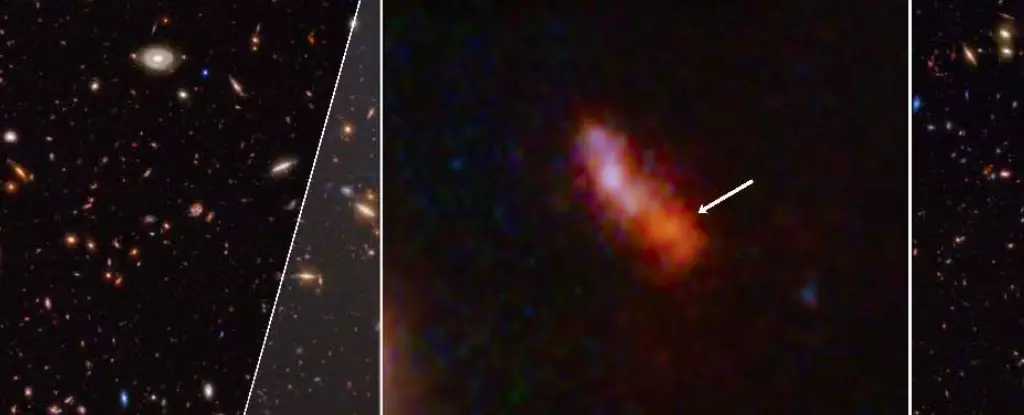The James Webb Space Telescope (JWST) continues to astonish the scientific community by expanding the boundaries of our cosmic knowledge. Recently, it achieved a remarkable feat by detecting light from MoM-z14, a galaxy existing just 280 million years after the Big Bang. This discovery not only establishes MoM-z14 as the most distant galaxy to date, but also underscores the JWST’s capacity to unveil findings that reshape our comprehension of the early universe.
Before the advent of the JWST, our capabilities to observe such distant galaxies were severely limited. Tools like the Hubble Space Telescope, with its 2.4-meter mirror, and the Spitzer Space Telescope, featuring an 85 cm mirror, fell short in revealing light from galaxies formed in the nascent stages of cosmic history. However, the JWST, equipped with a vastly superior telescope diameter and cutting-edge detector technology, is dramatically transforming our ability to peer into the light of antiquity. The JWST’s extraordinary advancements serve to lift the cosmic veil, revealing ancient galaxies that shed light on the universe’s formative years.
Revealing Surprises in the Cosmic Landscape
The JWST’s findings reveal a surprising abundance of luminous galaxies at redshifts exceeding z=10, challenging previous expectations of a sparse early galaxy population. With MoM-z14 sitting at a redshift of z=14.4, researchers are confronted with significant questions about galaxy formation and evolution that could redefine not only our understanding of the early universe but also the cosmic narrative as a whole.
The excitement generated by these discoveries, including the notable investigation conducted by lead author Rohan Naidu from the MIT Kavli Institute for Astrophysics and Space Research, encapsulates the thrill that permeates the astrophysical community. The revelations point toward an era far richer in early galaxies than once anticipated, which has profound implications for the processes that governed their formation.
A Deep Dive into MoM-z14’s Unique Characteristics
MoM-z14 presents as a galaxy predominantly aglow with the light of its stars rather than an active galactic nucleus (AGN). This information challenges preconceived notions about the early universe’s physical dynamics. Typically, AGNs, powered by supermassive black holes, are believed to dominate in brilliance at varying stages of the galaxy lifecycle. The absence of such a nucleus in MoM-z14 allows for fascinating inquiries into stellar formation processes, suggesting the presence of ultra-luminous supermassive stars, an integral piece in the cosmic puzzle.
Notably, the chemical attributes of MoM-z14 parallel those found in the Milky Way’s ancient globular clusters. Its elevated nitrogen-to-carbon ratio indicates that the stars within MoM-z14 were birthed in environments exhibiting similar chemical evolution patterns as earlier cosmic structures. This connection hints at a continuity through time, showing potential linkages among stellar populations throughout the eons.
The Relationship Between Morphology and Chemical Composition
As scientists scrutinize the morphology of MoM-z14, intriguing patterns emerge. The galaxy’s classification into point source and extended types—coupled with observed chemical abundances—offers critical insights into the evolutionary paths of early galaxies. Researchers postulate a relationship in which the morphology of galaxies may indeed reflect their underlying chemistry, paving the way for deeper understanding of how early galaxies evolved.
With the emerging class of nitrogen-emitting galaxies, including MoM-z14, another layer is added to the tapestry of galactic evolution. This highlights a potential bimodal behavior regarding size and chemical output, as point-like sources exhibit distinct properties when compared to their more extended counterparts. Researchers emphasize that the comprehensive nature of their findings clarifies the structural complexities shaping these distant galaxies.
The Cosmic Journey Ahead
Reflecting on the long-awaited launch of the JWST, it’s obvious that the observations it has kicked off are only the beginning. What’s thrilling is the potential discoveries awaiting us, amid the next celestial reveals that may come from both JWST and the anticipated Roman Space Telescope. Collectively, these telescopes are geared to uncover thousands more ancient galaxies, establishing connections and unlocking new cosmic mysteries.
Ultimately, the JWST stands at the forefront of astronomical exploration, showcasing how each remarkable discovery shapes our understanding of the universe and redefines what humanity perceives as possible in the realm of cosmic inquiry. As we watch the boundaries of what we know expand, we find ourselves perched on the precipice of an exciting new epoch in our exploration of the universe, where the first stars are no longer distant dreams but tangible targets for investigation.


Leave a Reply